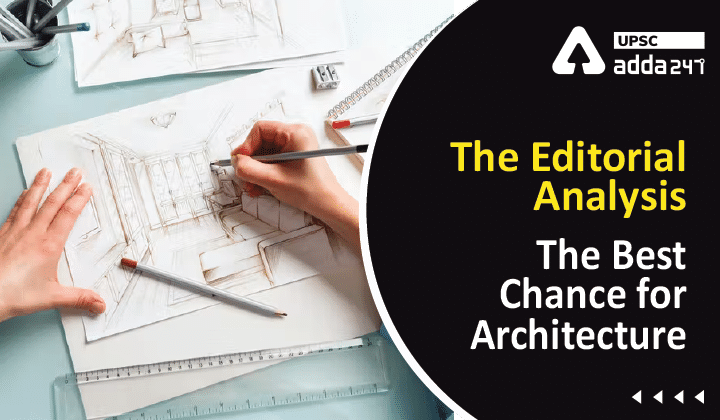Table of Contents
The Best Chance for Architecture- Relevance for UPSC Exam
- GS Paper 2: Governance, Administration and Challenges- Government policies and interventions for development in various sectors and issues arising out of their design and implementation.
The Best Chance for Architecture- National Educational Policy (NEP)
- Recent documents give a sense of how the National Education Policy (NEP) will play out in professional education, especially in Architecture.
Administration of Professional Education in India
- Keeping Professional Education outside NEP
- Many architects hold the firm view that professional education should be left to professionals.
- They argue that practitioners can steer professional education better, as they now do through the Council of Architecture (CoA).
- They demand that NEP limit itself to the humanities, science, and at the most include engineering.
- Keeping Professional Education within the NEP
- An uninspiring approach, poor training, low employability of graduates and a choking regulatory framework undermine the discipline.
- This provides a ground for NEP to set the house in order.
Architectural Education in India
- The architecture was clubbed with engineering as ‘technical education and brought under the Education Ministry.
- It came under the purview of the All-India Council for Technical Education (AICTE), set up in 1945.
- By the time the AICTE got its statutory footing in 1987, the Architects Act was enacted in 1972, and education came under the purview of an independent CoA.
- However, this did not shift it to the Ministry of Housing and Urban Affairs, which would have been more professionally aligned as law and medicine are with their respective nodal ministries.
Associated Concerns with the Architectural Education in India
- Long Duration of Program: While design and engineering are four-year undergraduate programmes, architecture is a five-year programme.
- The justification has been that a long and rigorous course is necessary since institutions train profession-ready students.
- Inadequate Industry Connection: The regulations do not adequately support industry connections. Those who try incur heavy additional expenses. As a result, many colleges have inadequate exposure.
- Lack of Specialization: Despite architecture practice scaling up and becoming multidisciplinary, education offers less scope for diverse specialisations and does not equip students to solve complex design problems.
How can NEP bring progressive practices to architectural education?
Four key NEP recommendations can change the course-
- NEP seeks a close connection between education and profession, and directs professional bodies such as the CoA to set standards that education will strive to meet.
- It means that though education commences in campus, it will mature in practice.
- Undergraduate courses should be liberal, allowing students to be trained and to help identify their paths.
- Unlike the current model that trains only a professional apprentice, NEP enables students to take either a practice or a research route.
- This is bound to pave the way for diverse programmes and support research training.
- Autonomy will be granted to institutions, which will save them from stifling regulatory arrangements and the standardised programmes they push.
Way Forward- Implementing NEP’s Recommendations
- Restructuring the Architectural Program: NEP’s mission to restructure undergraduate education as a three-year, liberal, broad-based education bodes well for architecture.
- Shorter programmes can build sufficient capacities to work as apprentices in industry/field-based organisation.
- When combined with another two years of specialisation and an equal number of years of work experience, the student is better trained as a professional.
- Ensuring Flexibility: Multiple entries and exits to programmes also enhance flexibility.
- After three years, students with an aptitude for research can take another path.
- Ensure Institutional Autonomy: For all these to become a reality, institutions need autonomy which is promised by NEP.
- The world over, professional bodies focus on professional standards and let academic institutions decide their creative ways to meet the objectives.
- Creating Space for Personal Development: Architecture institutions pack semesters with many subjects. They far exceed an average of 55 hours work week and deny space for the pursuit of personal development.
- NEP recommends a choice-based 20-credit-per-semester workload, creating a better space for students to explore.
- Maintaining Adequate faculty-student ratio: By allowing 50% of the staff required to be filled by visiting faculty, NEP enables more practitioners to teach.
Conclusion
- To convert the above recommendations to transformative changes, NEP has to keep to its promise and architects have to embrace changes.



 TSPSC Group 1 Question Paper 2024, Downl...
TSPSC Group 1 Question Paper 2024, Downl...
 TSPSC Group 1 Answer key 2024 Out, Downl...
TSPSC Group 1 Answer key 2024 Out, Downl...
 UPSC Prelims 2024 Question Paper, Downlo...
UPSC Prelims 2024 Question Paper, Downlo...
